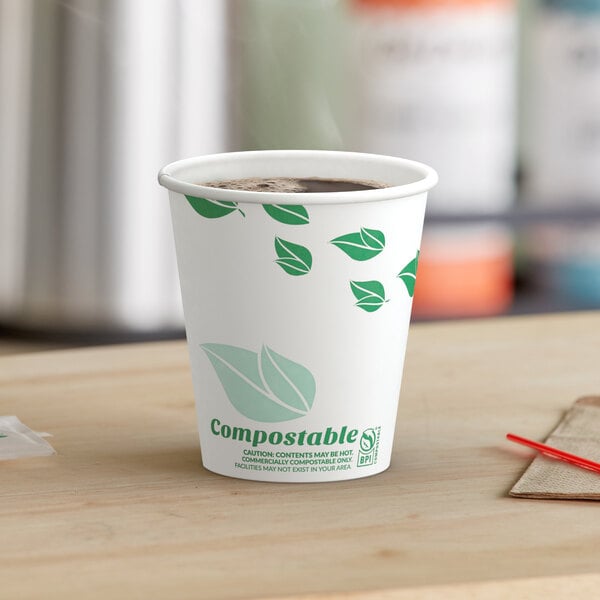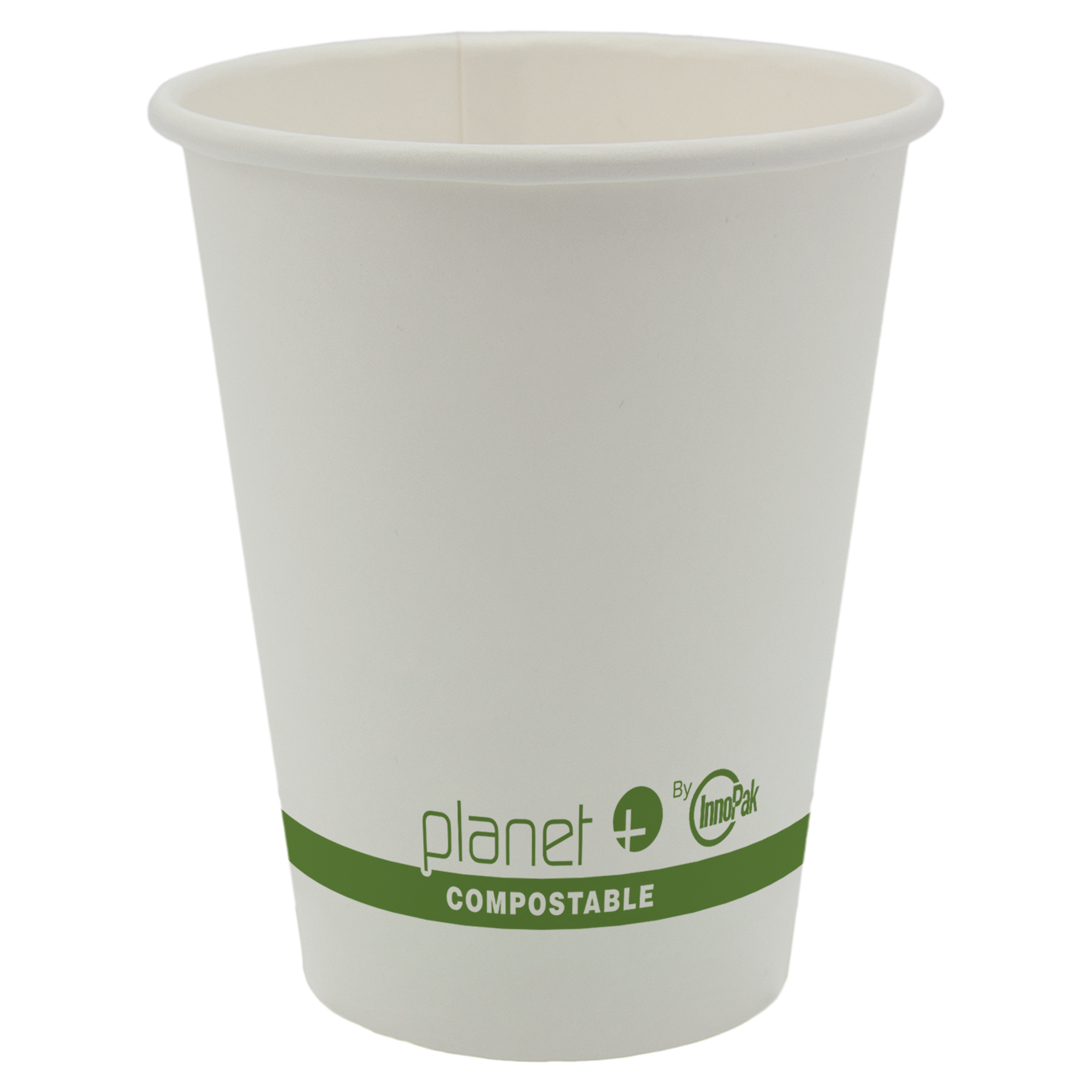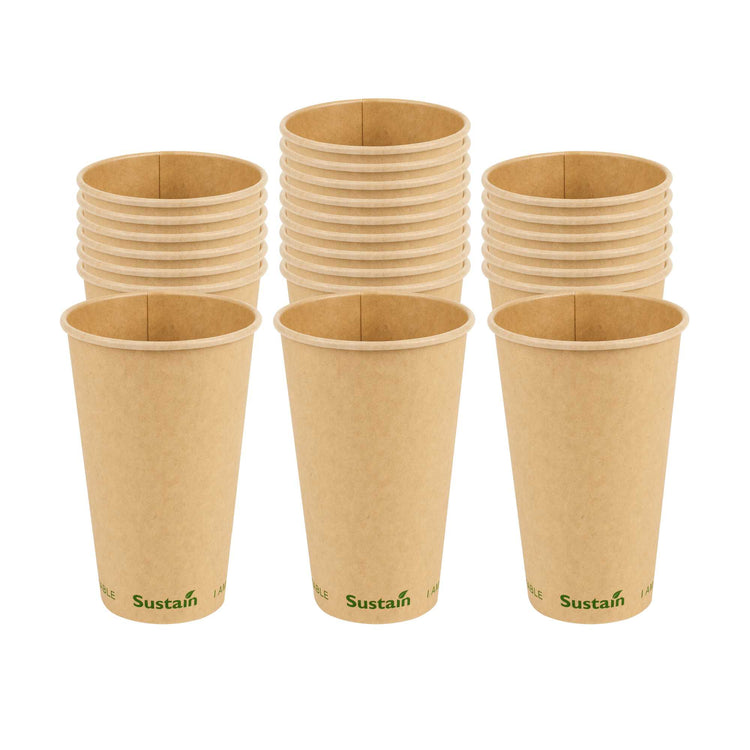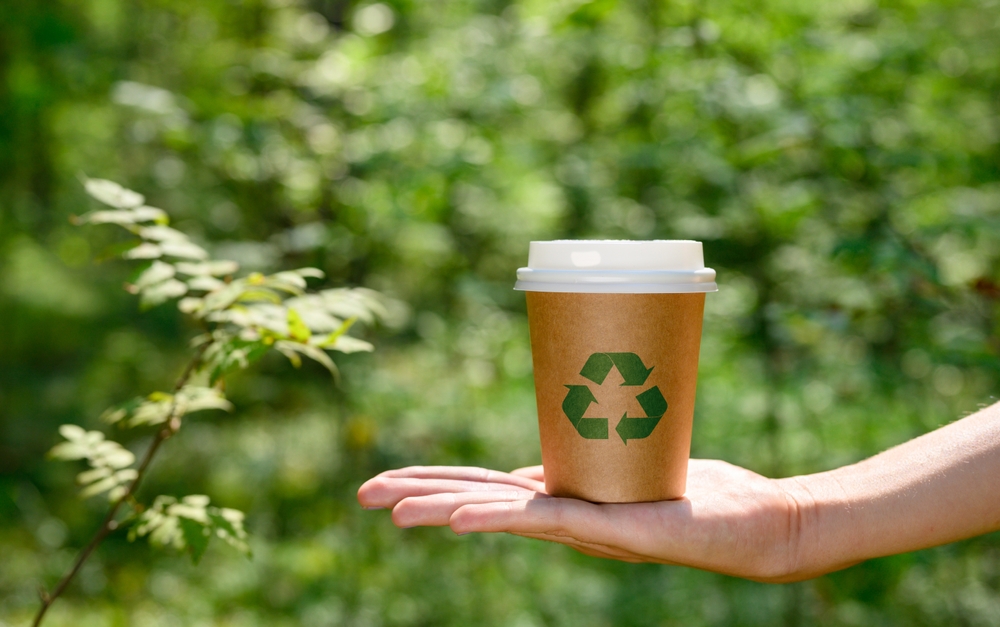Biodegradable paper coffee cups offer a real way to cut waste and help the planet. They use plant-based materials and special linings that break down faster than regular plastic cups. Though they cost a bit more, their benefits far outweigh that. Proper disposal, like industrial composting, is key to their success. With more brands and better recycling options, these cups are becoming easier to find and use. As laws tighten and customers demand greener choices, biodegradable cups will keep growing in popularity. Choosing these cups means supporting cleaner waste and a healthier future.
Materials and Manufacturing of Biodegradable Paper Coffee Cups

Paperboard and Fiber Components
Biodegradable paper coffee cups rely on sustainable, renewable paperboard as their main structure. This paperboard usually weighs between 150-350 g/m² to provide needed stiffness and durability for hot beverages like coffee. Instead of harmful fluorochemicals, manufacturers use liquid-repellent sizing agents such as alkyl ketyl dimer or alkyl succinic anhydride. These agents improve the paper’s resistance against liquids while making the cup safer and more eco-friendly. Fiber quality is critical here because it affects cup strength, heat insulation, and overall user comfort. Good fiber selection ensures the cup stays sturdy when filled with hot drinks and insulates against heat loss, eliminating the need for extra sleeves.
Biodegradable Barrier Linings
Traditional paper cups use polyethylene liners for liquid resistance but face issues like non-recyclability, slow degradation, and microplastic pollution. In response, newer barrier coatings have appeared, including aqueous coatings and bioplastics such as PLA (polylactic acid) and PHA (polyhydroxyalkanoates). Some biopolymers are derived from plant oils like canola, offering fully compostable solutions. These innovations maintain liquid resistance, heat sealability, and aroma preservation, comparable to PE liners, but are industrially compostable within about one month at temperatures between 50-60°C. Some aqueous coatings are even BPA-free and biodegradable in marine environments, reducing toxic leachates significantly.
| Barrier Lining Type | Compostabilità | Temperature for Composting | Additional Benefits |
|---|---|---|---|
| Polietilene (PE) | Non-compostable | N/D | Traditional, but polluting |
| PLA (Polylactic Acid) | Industrially compostable | 50-60°C | Renewable source, good liquid resistance |
| PHA (Polyhydroxyalkanoates) | Industrially compostable | 50-60°C | Derived from canola oil, fully compostable |
| Aqueous Coatings | Industrially & Marine Compostable | 50-60°C | BPA-free, less toxic leachates |
Design Features Enhancing Usability and Sustainability
Biodegradable cups often come in single-wall or double-wall designs. Double-wall cups provide extra insulation and comfort without requiring additional sleeves, helping reduce overall material use. Heat seal lines improve the cup’s structural integrity and durability, preventing leaks under hot liquid conditions. Many manufacturers offer custom biodegradable liners that match compatibility with compostable lids and sleeves, enhancing product sustainability. These design choices improve user experience while supporting circular economy goals.
Manufacturing Process Considerations
Producing biodegradable paper coffee cups involves balancing barrier function, cost, and manufacturing compatibility. Innovations address difficulties in achieving liquid resistance and heat sealability without compromising compostability. Companies currently use commercial technologies that allow consistent production quality at scale. However, maintaining affordability while meeting circular economy objectives remains a challenge. Manufacturers continuously optimize materials and processes to ensure reliable, eco-friendly cups that perform well in industrial composting facilities.
Environmental Benefits and End-of-Life Management

Environmental Impact Reduction
Biodegradable paper coffee cups break down much faster and safer than conventional plastic-lined cups, which can persist in landfills for over 20 years and release harmful microplastics. Under industrial composting conditions of 50-60 °C, biodegradable cups typically decompose 60-90% within one month. In contrast, home composting at 25-35 °C takes 3 to 6 months due to lower temperatures slowing the process. Cups coated with BPA-free aqueous linings are marine biodegradable and avoid toxic leachates, protecting ecosystems better than polyethylene-lined cups. These eco-friendly coffee cups help reduce landfill volume and minimize pollution, supporting circular economy goals.
| Degradation Method | Temperature Range | Decomposition Duration | Impatto ambientale |
|---|---|---|---|
| Compostaggio industriale | 50-60°C | 60-90% in 1 month | Fast, reduces landfill waste |
| Home Composting | 25-35°C | 3-6 months | Slower, less effective |
| Landfill (Plastic-lined) | Ambient | >20 years | Persistent microplastic pollution |
Disposal Methods and Infrastructure
The preferred disposal method for compostable coffee cups is industrial composting. However, access to such facilities remains limited worldwide, restricting the cups’ full environmental benefits. Some biodegradable cups with aqueous linings or PLA blends can also be broken down in home and curbside composting programs, broadening disposal options. Recycling polyethylene-lined cups is challenging because mixed materials and contamination limit processing to less than 1% globally. Emerging technologies aim to separate materials for recycling but are still developing. To dispose responsibly, consumers and businesses should first check local composting availability and avoid disposing cups in regular trash or recycling bins, where biodegradation or recovery is unlikely.
Certification and Eco-labeling
Recognized certifications like ASTM D6400 and EN 13432 verify that a coffee cup is truly compostable and biodegradable under specified conditions. These eco-certifications build consumer trust by ensuring products meet rigorous environmental standards and regulatory requirements. For businesses, using certified biodegradable cups helps demonstrate compliance with bans on fossil-based single-use plastics and signals commitment to sustainability. Clear eco-labeling also educates end-users on correct disposal methods, improving composting participation and reducing contamination.
| Certificazione | Standard | Purpose | Benefit |
|---|---|---|---|
| ASTM D6400 | USA Standard | Defines compostability in industrial facilities | Consumer trust, regulatory compliance |
| EN 13432 | EU Standard | Sets criteria for packaging compostability | Ensures biodegradability and eco-labelling |
| Custom Eco-labeling | Varies | Education & marketing tool | Improves disposal behavior |
Pros and Cons of Biodegradable Cups
Biodegradable cups offer several advantages: they reduce waste accumulation, improve circularity by returning organic matter to soil, and align with consumer preferences for sustainable packaging. These cups also help companies comply with increasing regulations against plastic usage. On the downside, biodegradable cups often come at a cost premium compared to traditional options. Their environmental benefit depends on proper disposal behavior and access to industrial composting infrastructure, which can vary greatly. Occasionally, biodegradable cups may also trade off some durability or heat insulation compared to plastic-lined counterparts but are improving with innovative designs. Overall, biodegradable paper coffee cups present a practical step toward more eco-friendly beverage packaging.
Market Options and Buying Guide for Biodegradable Paper Coffee Cups

Leading Brands and Product Types
Several leading brands provide a wide range of biodegradable paper coffee cups using different lining technologies. Greenprint, Phade, World Centric, Go-Compost, and Good Start Packaging are some top names. These brands offer cups lined with aqueous coatings, PLA (polylactic acid), or PHA (polyhydroxyalkanoates), ensuring compostability and liquid resistance. Their product lines cover both hot and cold cups, with sizes suited for everything from small cafes to large events. Bulk purchase options allow cost savings for hospitality businesses, while custom printing helps brands showcase their sustainability commitments with personalized logos or messaging. For example, Good Start Packaging offers fully compostable cups with PHA linings made from renewable canola oil, ideal for hot beverages. Meanwhile, Go-Compost provides cups that break down at home, thanks to BPA-free aqueous coatings. To learn more about custom options, check out our guide on custom printed paper cups.
Hot vs. Cold Beverage Cup Options
Biodegradable cups are designed differently for hot and cold drinks to ensure performance and comfort. Hot beverage cups typically have thicker, stiffer paperboard and sometimes double-wall construction to insulate hands from heat without needing sleeves. These cups use linings like PHA or PLA that withstand higher temperatures while maintaining compostability. Cold cups, on the other hand, use thinner paper and linings optimized for chilled drinks like iced coffee, juices, or smoothies. Their design focuses on preventing condensation and maintaining structural integrity without becoming soggy. The choice of lining impacts compostability and temperature tolerance: PLA-lined cups need commercial composting, whereas aqueous-lined cold cups can often compost at home.
| Tipo di tazza | Paperboard Thickness | Lining Type | Compostabilità | Typical Use |
|---|---|---|---|---|
| Hot Beverage | Thick, sometimes double-wall | PHA, PLA | Compostaggio industriale | Caffè caldo, tè |
| Cold Beverage | Thin | Aqueous coatings | Home and industrial composting | Iced coffee, smoothies |
Price and Affordability Factors
Biodegradable coffee cups usually cost more than conventional polyethylene-lined cups due to newer materials and manufacturing processes. Current price premiums vary but typically range from 10% to 30% higher per unit. However, bulk orders can reduce costs significantly, making them competitive for businesses with volume needs. Economies of scale are improving as consumer demand surges and production technologies mature. To find affordable eco-friendly coffee cups, buyers should consider suppliers offering mixed bulk packs or minimal branding to reduce customization expenses. Investing in quality biodegradable cups can save money long-term by aligning with government regulations on plastic bans and attracting eco-conscious customers.
Online and Retail Purchasing Channels
For bulk biodegradable coffee cups, online platforms like Amazon and specialty eco-packaging suppliers remain the most convenient options. These sites give access to larger selections, customer reviews, and competitive pricing on compostable cups suited for events and hospitality. Physical retail stores, including some grocery chains like Albertsons, carry smaller quantities or consumer packs but offer limited variety and sizes. Businesses planning large events or hospitality service should rely on online bulk buying to secure stock, ensuring supply consistency and quick delivery. Some suppliers also provide subscription services and direct shipping for ongoing convenience.
Additional Services and Accessories
Many biodegradable cup manufacturers also offer complementary products and services to enhance the sustainability of coffee packaging. Composting equipment, such as small industrial compost bins, is available to facilitate end-of-life management on-site. Eco-friendly lids, sleeves, and stirrers matching the compostable cups ensure a fully disposable and environmentally responsible package. Value-added services like consultation on waste sorting and composting programs help businesses implement circular waste practices. Suppliers often provide certifications and labelling support to foster consumer trust and regulatory compliance, important for marketing biodegradable coffee cups effectively.
Sustainability Trends, Legislation, and Consumer Demand in Coffee Cup Industry

Growing Regulatory Pressure
Governments worldwide have started banning single-use fossil-based plastics such as conventional polyethylene-lined coffee cups. The European Union, Australia, Taiwan, and India have implemented phased bans and policies targeting 2023 to 2030, pushing the coffee cup industry toward biodegradable alternatives. These regulations accelerate innovation by requiring cups to be compostable or recyclable, which traditional plastic-lined cups fail to meet due to their delayed degradation of over 20 years and microplastic pollution risks. Consequently, manufacturers invest in bioplastics like PLA, PHA, and aqueous coatings to comply with eco packaging standards. These shifts help reduce landfill waste but demand supporting infrastructure for collection and industrial composting.
Consumer Preferences and Market Drivers
Millennials and Gen Z consumers increasingly demand eco-friendly coffee cups, favoring biodegradable, compostable, and fiber-based options over fossil-based plastics. Awareness campaigns highlighting the environmental drawbacks of plastic-lined cups influence buying habits, with transparency through eco-certifications like ASTM D6400 and EN 13432 boosting trust. This demographic shift drives market growth for sustainable packaging solutions, encouraging businesses to adopt green packaging for coffee cups to meet consumer expectations. Disposable eco-friendly coffee cups offer a practical balance between convenience and sustainability, appealing to this environmentally conscious segment.
Industry Innovation and Challenges
Bioplastics and advanced fiber technologies continue to enhance sustainable coffee cup design. Innovations like plant-based PLA linings, aqueous barrier coatings, and PHA derived from canola oils improve compostability without compromising liquid resistance, aroma preservation, and heat sealability. Double-wall paperboard designs enhance insulation while reducing the need for sleeves. However, balancing cost, material performance, and ease of disposal remains challenging. Companies also face hurdles integrating circular economy systems, needing efficient collection, sorting, and reprocessing to avoid contamination and ensure biodegradation. The industry’s ongoing commitment to improving eco packaging standards is crucial for widespread adoption.
Future Outlook
The biodegradable paper coffee cup market is set to grow rapidly due to sustainability mandates and rising consumer demand. Expansion of industrial composting infrastructure will support faster biodegradation, with many cups breaking down 60-90% within a month under optimal conditions. Future materials will likely include hybrid blends optimizing home and commercial compostability to meet diverse disposal contexts. Continued improvements in biodegradable cup liners and manufacturing processes promise enhanced performance and reduced costs, making sustainable coffee packaging more accessible for businesses of every size. This growth aligns closely with global environmental goals to reduce plastic pollution and promote circular resource use.
| Trend or Factor | Descrizione | Impact on Industry |
|---|---|---|
| Regulatory Bans | Phasing out fossil-based plastics globally | Drives adoption of biodegradable cups |
| Consumer Demand | Growth among Millennials and Gen Z | Increases market size and innovation |
| Innovation | New bioplastics and barrier technologies | Improves product performance and eco-friendliness |
| Infrastructure Expansion | Increasing industrial composting facilities | Facilitates effective end-of-life management |
FAQs about biodegradable paper coffee cups:
What are biodegradable paper coffee cups?
Biodegradable paper coffee cups are cups made from materials that can naturally break down and decompose in the environment over time. These cups typically use plant-based fibers and biodegradable coatings instead of traditional plastic linings. This design helps reduce environmental pollution and landfill waste compared to conventional disposable coffee cups.
How do biodegradable paper coffee cups degrade?
Biodegradable paper coffee cups degrade through natural processes involving microorganisms, moisture, and oxygen. The materials used in these cups, such as plant fibers and compostable linings, break down into harmless substances like water, carbon dioxide, and biomass. Proper disposal in composting facilities can significantly speed up their decomposition.
Are biodegradable paper coffee cups compostable?
Biodegradable paper coffee cups can be compostable if they meet specific standards that allow them to break down entirely in composting conditions. Not all biodegradable cups are fully compostable, so it’s important to check for certifications indicating industrial or home compostability to ensure they can safely be added to compost.
Do biodegradable paper coffee cups contain plastic?
Biodegradable paper coffee cups may contain small amounts of biodegradable plastic or plant-based polymers used as linings to prevent leaks while maintaining compostability. Unlike traditional plastic linings, these materials break down naturally, minimizing environmental impact. Always verify the cup’s material details and certifications for confirmation.
